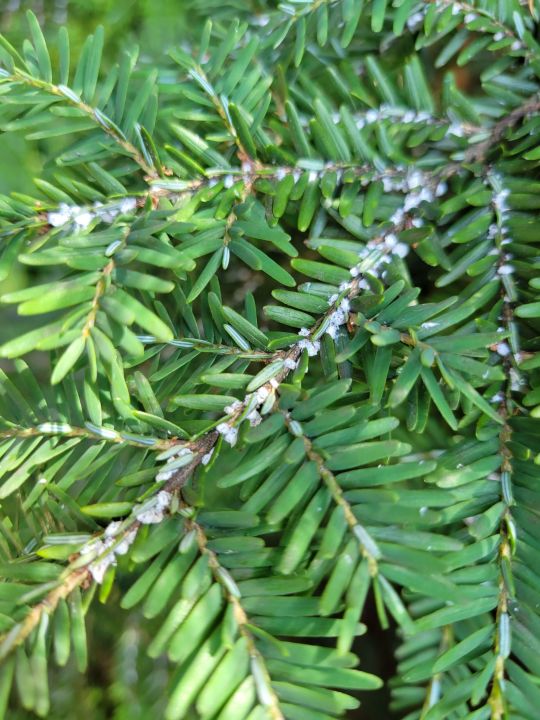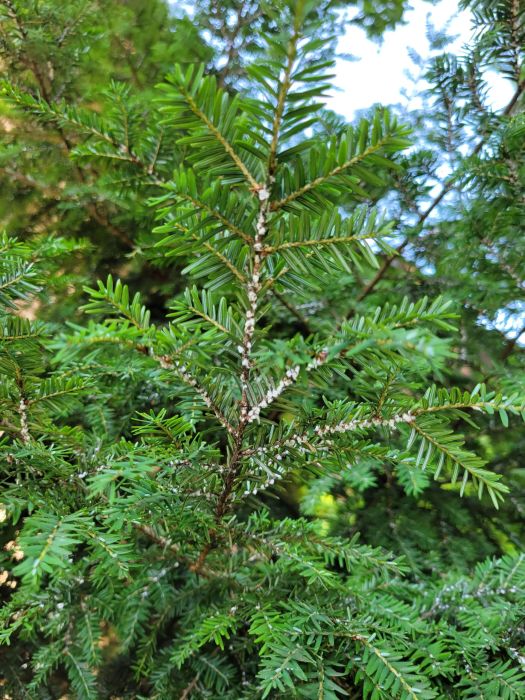The Hemlock Woolly Adelgid: Spotlight on an Invasive Species of Pennsylvania
In the fourth installment of our series on invasive species of insects, we will discuss the hemlock woolly adelgid. The hemlock woolly adelgid (HWA, or adelges tsugae) is a tiny, sap-sucking insect native to East Asia. Recognized as an invasive species in the United States, the pest has been identified in multiple states and was found in Pennsylvania in the late 1960s. The HWA is a significant threat to eastern hemlock trees, the state tree of Pennsylvania.
As plant health care professionals, we want to help you and other Pennsylvania residents understand the impact of this invasive pest and keep your hemlock trees safe. Below, we discuss the characteristics, life cycle, damage and treatment of hemlock woolly adelgid in Pennsylvania.
Identifying the Hemlock Woolly Adelgid
Adelgids are a small family of insects closely related to aphids that feed on the plant sap of conifer trees and, in the hemlock woolly adelgid’s case, hemlock and spruce trees. The insect measures less than 1/16 inch (1.5mm) and is covered in a wool-like wax filament, giving the pest a “cottony” appearance. Females are black, oval, soft-bodied, and about 1.5 mm long. HWA is primarily found on the underside of hemlocks’ branches, nestled against the base of the needles.
The Life Cycle of the HWA
The hemlock woolly adelgid possesses an intricate two-year life cycle, encompassing four immature stages and culminating in a reproductive adult phase. Throughout late winter and early spring, as temperatures climb, adult female HWAs begin laying eggs. These clusters of eggs, housed within white filamentous wax masses, continue to be laid until June. Measuring 0.25 mm in length and 0.15 mm in width, the oblong eggs have a brownish-orange color. Depending on the warmth of the spring season, hatching starts in early April and typically concludes by the end of June.
Emerging as reddish-brown nymphs, or “crawlers,” these young insects display a delicate white fringe near their anterior. Once settled, crawlers grow to approximately 0.3 mm long, and take on a black hue with a white fringe that encircles their bodies and extends along their dorsal side. As these nymphs develop, their color deepens to a dark reddish-brown, and their size progressively increases due to active feeding habits. By late September, these mature female insects reside on trees, overwintering before repeating the reproductive process of the species.


Recognizing an Infestation
The most apparent sign of HWA infestation is the white, “cottony” egg sacs on the underside of hemlock branches that the females produce when laying eggs. These egg sacs look much like the tip of a cotton swab and typically persist even after the insects are dead. Other signs include needle loss, reduced twig growth, and dieback of branches.
Damage Caused by Hemlock Woolly Adelgid
The impact of an HWA infestation on eastern hemlock trees can be catastrophic to the tree, depending on the extent of the infestation. The adelgids use sharp, syringe-like mouthparts, or stylets, to siphon off essential plant fluids from host plants. This feeding activity takes a toll on the plant’s overall health.
A moderate population of the hemlock woolly adelgid may lead to a noticeable decline in the health and vigor of your trees. However, the consequences become more serious in a severe infestation. This could result in a premature shedding of needles, diminished growth of twigs, significant dieback, and in worst cases, the loss of the tree. This danger to the trees makes early detection and decisive action in managing these unwelcome pests important.
Managing & Controlling Hemlock Woolly Adelgid
We are often asked to manage this pest in late September through October. We use several methods for managing infestations of hemlock woolly adelgid.
Insecticides
Registered systemic insecticides applied in late September and October can reduce hemlock woolly adelgid populations and temporarily prevent the establishment of new infestations for up to seven years. These systemic insecticides are usually injected into tree trunks or applied as a soil drench or injection. These insecticides often target overwintering females.
A plant health care expert can also apply sprays during other times of the year. A mid-to-late June spray may help reduce the number of developing nymphs. This management strategy is appropriate when thorough coverage is difficult to achieve using ground application equipment. Early spring soil injections usually work well against this pest when the soil is sufficiently irrigated.
Biological Control
Predatory insects can also be used to control HWA populations. The species most commonly used for this application are Laricobius nigrinus, a beetle native to the western United States, and Sasajiscymnus tsugae, a beetle native to Japan. Both beetle species are attracted to the white woolly egg masses that HWA produces. In addition, the beetles feed on the HWA, and their larvae also feed on the pest.
While most often used in forests, this method is becoming more common for residential hemlock trees in the United States. This is because biological controls to remove species of harmful pests can be a more environmentally friendly method of control than using chemicals. As with insecticides, a qualified arborist should perform this treatment. A certified arborist can help you assess the severity of the infestation and recommend the best course of action.
Contact Burkholder PHC for Hemlock Woolly Adelgid Treatment in Your Landscape
If you suspect or are concerned about the presence of hemlock woolly adelgid on your property, contact Burkholder PHC for expert advice and treatment options. We provide a free evaluation by our highly experienced, qualified plant health care experts and certified arborists to help remove and control invasive species and the adverse effects these pests cause. Contact Burkholder PHC today for a free consultation.

